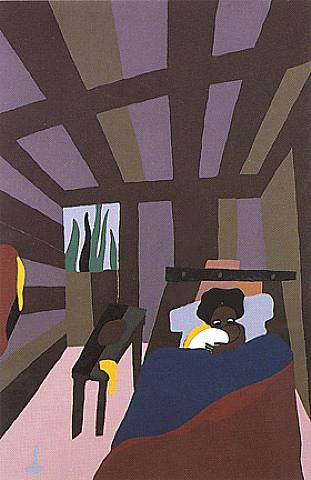The subject gains access to bliss by the cohabitation of languages working side by side: the text of pleasure is sanctioned in Babel. (The Pleasure of the Text – Roland Barthes)
I am all for the ecstasy of reading texts against each other. The frisson of comparison is generative for the reader. We make meaning of things based on what we already know; we see what we are already paying attention to. One function of art is to open up new perceptions. Great art changes the world through the way it changes our understanding of the world. I saw the Toussaint L’Ouverture prints for the first time by accident when I was at the Dallas Museum of Art for a friend’s event. Jacob Lawrence’s 15 silkscreen prints chronicling the life of the Haitian revolutionary took me by surprise. I had been thinking about how to teach a 2D Design course. In front of those prints, I wanted to instantly transport my students to see how intelligently Lawrence has taken an economy of design elements (color, shape, rhythm) to create a world of feeling, experience, and narrative.

Sitting in front of the Danish artist group Superflex’s video work: Flooded McDonalds a couple of weeks later in the Peter Blum gallery in Chelsea, I was thinking about the Jacob Lawrence prints. Both projects evoke the pleasure and/or horror related to states of separation and merging (you can watch a video clip of Superflex’s work here).
Lawrence has an uncanny ability to fix the liquid fluidity of life into precisely defined forms. In translating his early paintings into prints, Lawrence went through many proofs, correcting and perfecting until he was completely satisfied. The final prints often differ significantly from the original works. The resulting forms, though static on the page retain the energy of movement fueled partly by color juxtapositions. Greyed olive, naples yellow, puce, and charcoal vibrate against bright green, white, and neon red. In the precision of Lawrence’s forms there is a satisfaction that comes from the clarity of the boundaries. This shape is here and that one there. The medium of silkscreen reinforces this distinction. The way that the squeegee presses ink through the screen and onto paper yields color shapes with clear edges and an incredibly lush, flat, matt surface.

In Flooded McDonalds liquid fluidity is the main actor. The set is an entirely artist built replica of a McDonalds restaurant. The details are precise: backlit plexi menus, rectangular trash bins with the swinging door, food products in their familiar packaging, etc. Water enters the set from under a closed door. It slowly but steadily fills the entire space incompletely digesting the contents. What starts as discrete identifiable forms slowly becomes a soupy dirty brown green sea of murkiness. In an opening shot, Ronald’s shoes nearly fill the screen: shiny, bright, and seductive. Underwater shots from later in the video reveal seaweed like food fragments whirling about with waxed paper soft drink cups and hamburger wrappers. Ronald bobs, toppled in the background. The exaggerated audio emphasizes the relentless devouring force of the water, which somehow becomes inextricably linked to the power and fragility of McDonald’s economic and cultural domination.
Ronald McDonald is an internationally famous fiction while Toussaint L’Ouverture is a real hero who remains relatively obscure. Lawrence was a modern master who painted scenes from everyday life and historical narratives he knew to be interpenetrating the present. Superflex is a postmodern configuration, a collective of artists/designers working together to produce a vast array of products and events in a diverse range of contexts. Both projects ask us to look more deeply into our relationship to history, economics, and politics as they resonate with current events.
Go see the Toussaint L’Ouverture prints at the DMA. They are worth it. And Superflex is an excellent model for Dallas to examine in relation to public art and the questions surrounding our newly evolving arts district park area.
Photo: Jacob Lawrence, The Burning, 1997 (detail). The Collection of Curtis E. Ransom. Image courtesy of the Dallas Museum of Art.






